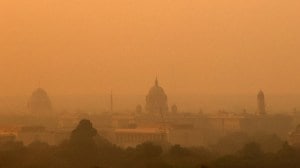Stay updated with the latest - Click here to follow us on Instagram
Inside outside
With his faded jeans,shuffling walk and hair carelessly knotted into a tousled ponytail,Bangladeshi artist Mahbubur Rahman is a picture of insouciant indolence.
A Bangladeshi artist captures the city in frozen frames
With his faded jeans,shuffling walk and hair carelessly knotted into a tousled ponytail,Bangladeshi artist Mahbubur Rahman is a picture of insouciant indolence. His art,on the other hand,is blatantly evocative and deeply personal.
His exhibition,Mumbai Tropism,which includes one installation,four sculptures,four drawings on digital prints and 15 photographs,continues at The Loft and The Blue Frog Studio till January 14. The photographs are a whirlwind documentary of the citys teeming life: A hapless cow causing traffic to come to a skidding halt at CST; a huddling canopy of khaki-clad figures; the starched smirk on a BEST bus drivers face.
The drawings are a mesh of the personal with the political. He uses an enlarged registration deed as a metaphor for a splintered piece of land that was passed down from his grandfather. The land formed a part of India and later Pakistan and in 1971,Bangladesh.
Rahman is one of Bangladeshs most challenging artists adept in painting,photography,print-making and sculpture. Indian art has progressed in leaps and bounds compared to art in Bangladesh in the last 10 years, feels the 40-year-old. Artists here are more open to experimentation.
Rahman is also a performance artist. In his last performance Transformation,he wore a faceless string hood mounted with buffalo horns and walked around the streets of Dhaka. His performance referred to the story of the farmer Nuruldunner Sarajiban,whose resistance to the British resulted in him having to pull his own plough instead of the buffalo. Performance art is about making a statement without caring what the audience thinks, says Rahman.
He has won numerous awards including the Best Award in Sculpture at the Dhaka 12th Young Artists Art Exhibition in 1998 and the Art for Amnesty-Best Award by Amnesty International in 1997.
Srila Chatterjee of Blue Frog Studio says,I first saw his work at the Devi Foundation Retrospective a few months ago and I was blown away. It was almost surreal when the opportunity to collaborate came our way.
Rahmans work might come as a breather for art greenhorns for whom it takes much eye-squinting and brain-racking to decipher artists messages in paintings. Every country I travel to,different meanings are attached to my art and thats how it should be, says the artist. The premeditated,he feels,should be taken out of the spontaneous,the intellectual out of the instinctive. After all,asks Rahman,what is art if not open to interpretation?







